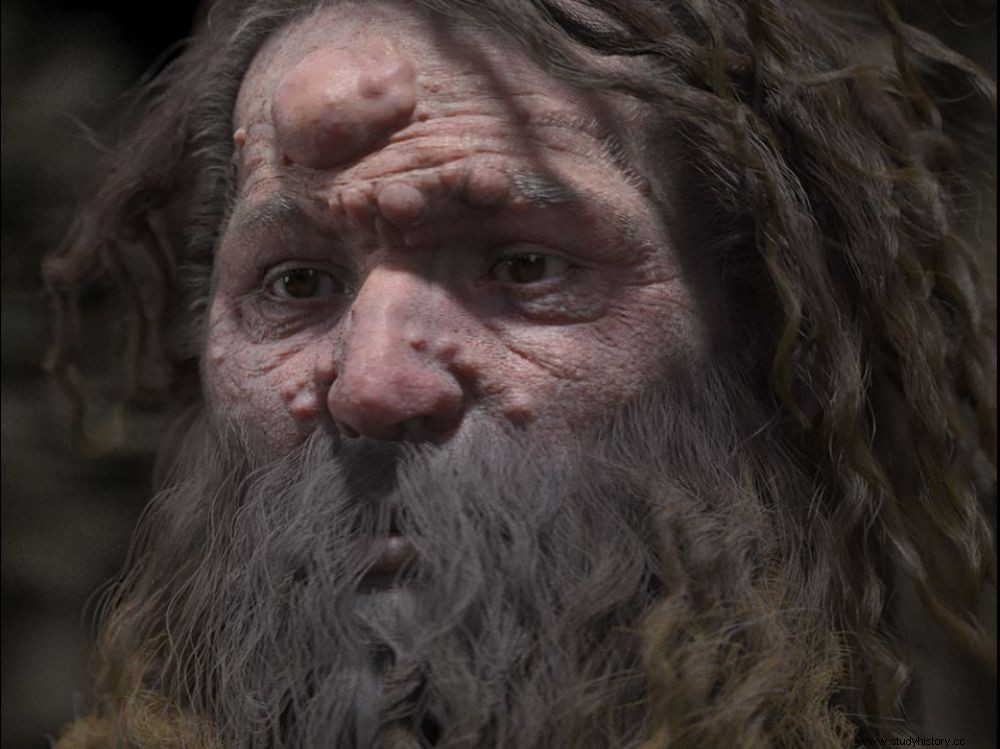The Cro-Magnon man would have suffered from neurofibromatosis, a genetic disease resulting in unsightly nodules on the face. This is the conclusion of a study by French researchers led by Philippe Charlier and Antoine Balzeau.

3D digital reconstruction of the face of Cro-Magnon Man 1 and its lesions.
PALEOANTHROPOLOGY. The famous Cro-Magnon man now has a face, but also surprising nodules… He would indeed have suffered from a genetic disease! For a long time Cro-Magnon man designated all the representatives of Homo sapiens, i.e. the modern men discovered in Europe during the Upper Palaeolithic… On the occasion of the 150 th anniversary of the discovery of his skeleton, in the Dordogne, by researchers from the University of Versailles-Saint-Quentin, in Montigny-le-Bretonneux (Yvelines), and the prehistory department of the Musée de l'Homme in Paris, after a reexamination of the so-called Cro Magnon 1 skull, kept at the Musée de l'Hommes, have just proposed a digital reconstruction.
With surprising results! By studying the skeleton of this 27,680-year-old ancestor unearthed in 1868 in a cave in Eyzies-de-Tayac (Dordogne), medical anthropologist Philippe Charlier and paleoanthropologist Antoine Balzeau, from the department of prehistory, the museum of humans, found that he was the carrier of a genetic pathology, causing benign tumors of the peripheral nerves, both superficial and deep of the neurofibroma type, that is to say unsightly nodules of larger or smaller size. “A “neurofibromastosis type 1” , said Philippe Charlier.
Published in the medical journal The Lancet , the scientists explain “that a direct anthropological and medical examination, followed by a micro-CT-scanner carried out at the National Museum of Natural History in Paris, made it possible to compare the data with those from the anatomical collections and pathological ”, thus contributing to the establishment of this diagnosis. “The skull of the Cro-Magnon man shows a lesion on the forehead which corresponds to the presence of a neurofibroma which would have eroded the bone. His left internal auditory canal was also damaged, presumably due to a tumour”, also added the medical examiner, questioned by AFP.
Cro-Magnon 1 would thus have been a carrier of Recklinghausen's disease, a genetic pathology generating tumors - benign -, which one can imagine very disabling socially. Once this fibromatosis was diagnosed, Philippe Charlier called on the talents of Philippe Froesch, (Visualforensic), known for his 3D digital facial reconstructions, including those of King Henri IV, Maximilien Robespierre, and Thomas Craven. Based in Spain, the expert relied on data from physical anthropology and forensic medicine to give a face to Cro-Magnon 1, to propose its digital reconstruction.

3D virtual reconstruction of the face of Cro-Magnon 1 from his skull kept at the Musée de l'Homme, in Paris. © Visualforensic
A fossil man called Cro-Magnon
Of the five skeletons found in the 19
th
century in the cave of Les Eyzies-de-Tayac (Dordogne) on the eponymous site, only that of Cro-Magnon 1 was complete. His study established that he was a man in his forties, affected by multiple pathologies. Anatomically modern, tall, this Homo sapiens belonged to the so-called Gravettian culture, chronologically located between the Aurignacian and the Solutrean, i.e. from -31,000 to -22,000 years ago.
